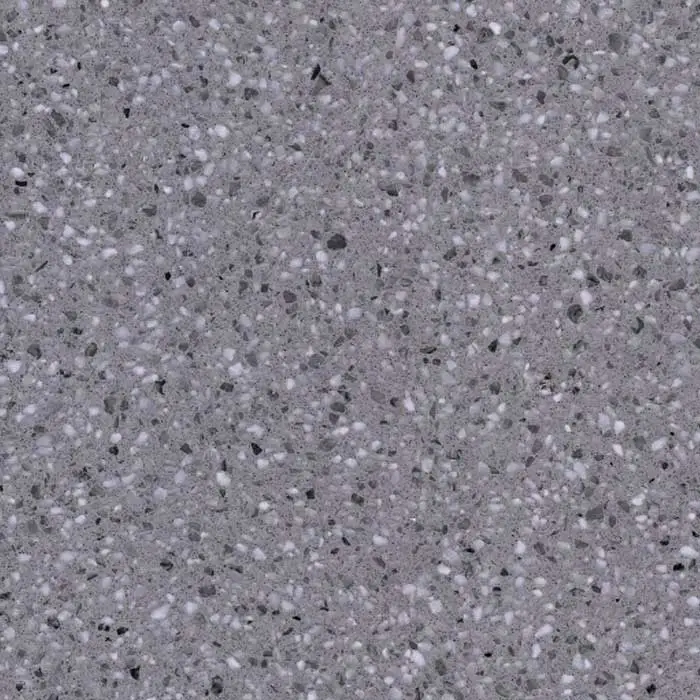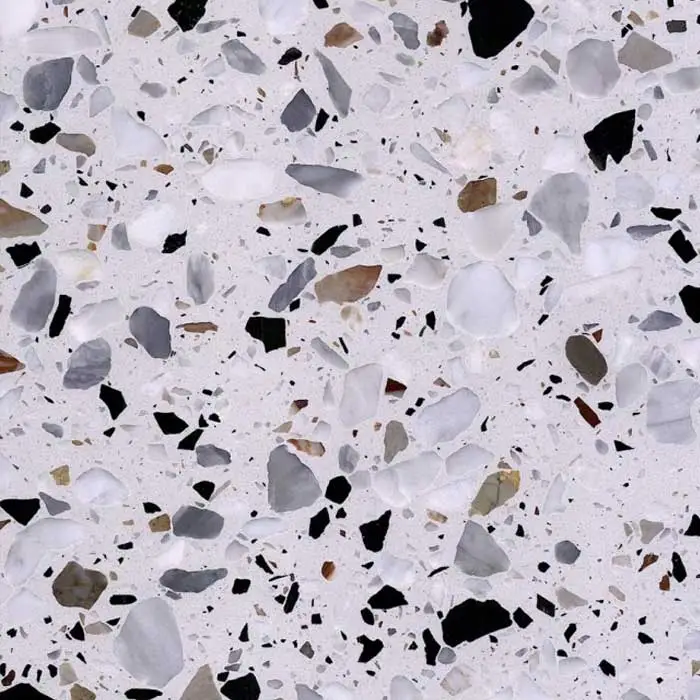From home decoration to commercial space, from public buildings to high-end hotels, terrazzo stone can be found everywhere. So, what is terrazzo stone? Why can it regain its luster in modern architecture?
This article will explore the definition, history, manufacturing process, advantages and disadvantages of terrazzo stone and its wide application, to help readers fully understand this classic and distinctive decorative material.

What kind of stone is terrazzo?
Terrazzo stone is a man-made composite material, a building material made by mixing crushed stone such as marble, quartz, and granite with cement and resin. After pouring, grinding, polishing and other processes, a decorative surface with smooth surface and diverse textures is formed. According to the cementitious material used, terrazzo stone can be divided into cement-based terrazzo stone and resin-based terrazzo stone.
The historical origin of terrazzo stone:
The history of terrazzo stone can be traced back to the ancient Roman period, when craftsmen at that time embedded crushed stone into a lime substrate to create a unique decorative effect. In the early 20th century, Italian architects brought this traditional craft into modern architecture, and terrazzo stone gradually became a common material for high-end architectural decoration. In the mid-20th century, with the invention of synthetic resins, the manufacturing process of terrazzo stone was further developed and improved.
What is the manufacturing process of terrazzo stone?
1. Raw material selection
The manufacturing of terrazzo stone first requires the selection of suitable raw materials, including crushed stone (such as marble, quartz, granite, etc.), cementitious materials (such as cement, resin), pigments and additives. The selection of raw materials directly affects the performance and aesthetics of terrazzo stone.
2. Mixing and pouring
The crushed stone, cementitious materials, pigments and additives are mixed evenly in proportion and poured into the mold for pouring. The mold needs to be vibrated during the pouring process to ensure that the material is evenly distributed and dense, and to avoid bubbles and gaps.
3. Grinding and polishing
The cast terrazzo stone needs to be cured and then undergo multiple grinding and polishing processes. Grinding uses grinding discs of different particle sizes, gradually grinding from coarse to fine until the surface is smooth and flat. The polishing process makes the surface of terrazzo stone brighter by waxing or applying polishing agent.
4. Sealing treatment
Finally, the terrazzo stone is sealed and a sealant is used to fill the tiny pores on the surface to increase the anti-fouling and anti-seepage properties. This step ensures the durability and easy cleaning of the terrazzo stone in actual use.

What are the advantages and disadvantages of terrazzo?
1. Advantages of terrazzo stone
●Beautiful and diverse: The color and texture of terrazzo stone can be freely adjusted according to design requirements to meet various decoration styles.
●Strong durability: Terrazzo stone has high hardness and wear resistance, and is suitable for high-traffic areas such as shopping malls, airports and subway stations.
●Easy to maintain: The surface of the sealed terrazzo stone is not easily penetrated by stains, and it is easy to clean and maintain.
●Environmental protection: The raw materials of terrazzo stone are mostly natural stone fragments, which have certain environmental protection.
2. Disadvantages of terrazzo stone
●Complex construction: The construction of terrazzo stone requires professional technology and equipment, and the construction period is long.
●Heavy weight: Due to the use of a large amount of stone fragments, terrazzo stone is relatively heavy and not suitable for some places with high structural requirements.
●Price fluctuations: The manufacturing cost of high-quality terrazzo stone is high and the price is relatively expensive.

Application areas of terrazzo stone
1. Home decoration
In home decoration, terrazzo stone can be used in multiple parts such as floors, walls, countertops and bathrooms. Its unique decorative effect and durability make terrazzo stone an ideal choice for kitchen, bathroom and living room floors. In addition, the diverse designs of terrazzo stone can add a sense of fashion and personalization to home spaces.
2. Commercial space
Terrazzo stone is widely used in commercial spaces, including shopping malls, restaurants, hotels and office buildings. Its wear resistance and easy cleaning properties are suitable for environments with high traffic and frequent cleaning. In addition, the design flexibility of terrazzo stone can meet the high requirements of commercial spaces for brand image and decoration style.
3. Public buildings
In public buildings, such as airports, subway stations, museums and theaters, terrazzo stone is widely used for floor and wall decoration. Its durability and beauty enable terrazzo stone to withstand large traffic and long-term use while maintaining good decorative effects.
4. Artistic decoration
The diverse designs and unique textures of terrazzo stone make it an ideal material for artistic decoration. In sculptures, murals, furniture and accessories, the application of terrazzo stone is becoming more and more diverse, providing rich inspiration and possibilities for artistic creation.

Conclusion
As a classic and distinctive architectural decoration material, terrazzo stone has a new vitality in modern architecture with its advantages such as beauty, diversity, durability and environmental protection. By deeply understanding the definition, history, manufacturing process, advantages and disadvantages of terrazzo stone and its application, consumers and designers can better choose and use this material to add unique charm and style to home and commercial spaces.

